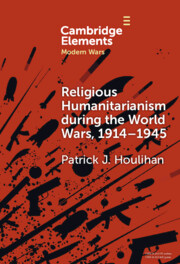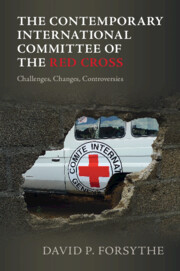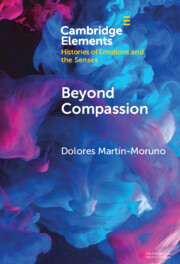164 results
Chapter 30 - Humanitarianism and armed intervention
- from Part 4 - The new agenda: Globalisation and global challenges
-
-
- Book:
- An Introduction to International Relations
- Published online:
- 31 August 2024
- Print publication:
- 12 August 2024, pp 398-414
-
- Chapter
- Export citation

Religious Humanitarianism during the World Wars, 1914–1945
- Between Atheism and Messianism
-
- Published online:
- 06 June 2024
- Print publication:
- 13 June 2024
-
- Element
- Export citation
Chapter 7 - Suffering, Sentiment, and the Rise of Humanitarian Literature in the 1830s
-
-
- Book:
- Nineteenth-Century Literature in Transition: The 1830s
- Published online:
- 30 May 2024
- Print publication:
- 06 June 2024, pp 147-169
-
- Chapter
- Export citation
Promoting the State through Food Scarcity: Czechoslovakia and the United States after World War I
-
- Journal:
- Austrian History Yearbook , First View
- Published online by Cambridge University Press:
- 08 March 2024, pp. 1-15
-
- Article
-
- You have access
- HTML
- Export citation
13 - Transforming Humanitarianism
-
-
- Book:
- Diversity and Precarious Work During Socio-Economic Upheaval
- Published online:
- 01 February 2024
- Print publication:
- 08 February 2024, pp 264-283
-
- Chapter
- Export citation
1 - Introduction
-
-
- Book:
- Civility, Barbarism and the Evolution of International Humanitarian Law
- Published online:
- 11 January 2024
- Print publication:
- 01 February 2024, pp 1-12
-
- Chapter
- Export citation
4 - Cultivating Humanitarianism
-
-
- Book:
- Civility, Barbarism and the Evolution of International Humanitarian Law
- Published online:
- 11 January 2024
- Print publication:
- 01 February 2024, pp 61-84
-
- Chapter
- Export citation

The Contemporary International Committee of the Red Cross
- Challenges, Changes, Controversies
-
- Published online:
- 01 February 2024
- Print publication:
- 01 February 2024
Conclusion
-
- Book:
- Selling French Sex
- Published online:
- 04 January 2024
- Print publication:
- 25 January 2024, pp 233-250
-
- Chapter
- Export citation

Beyond Compassion
- Gender and Humanitarian Action
-
- Published online:
- 09 November 2023
- Print publication:
- 07 December 2023
-
- Element
-
- You have access
- Open access
- HTML
- Export citation
Becoming a humanitarian state: A performative analysis of ‘status-seeking’ as statecraft in world politics
-
- Journal:
- Review of International Studies / Volume 50 / Issue 4 / July 2024
- Published online by Cambridge University Press:
- 06 November 2023, pp. 700-719
- Print publication:
- July 2024
-
- Article
-
- You have access
- Open access
- HTML
- Export citation
3 - Feeding the Mind
-
- Book:
- Feeding the Mind
- Published online:
- 07 October 2023
- Print publication:
- 05 October 2023, pp 86-119
-
- Chapter
- Export citation
4 - Knowledge Displaced
-
- Book:
- Feeding the Mind
- Published online:
- 07 October 2023
- Print publication:
- 05 October 2023, pp 120-154
-
- Chapter
- Export citation
2 - Feeding Bodies
-
- Book:
- Feeding the Mind
- Published online:
- 07 October 2023
- Print publication:
- 05 October 2023, pp 48-85
-
- Chapter
- Export citation

Feeding the Mind
- Humanitarianism and the Reconstruction of European Intellectual Life, 1919–1933
-
- Published online:
- 07 October 2023
- Print publication:
- 05 October 2023
1 - 1919
-
- Book:
- Feeding the Mind
- Published online:
- 07 October 2023
- Print publication:
- 05 October 2023, pp 17-47
-
- Chapter
- Export citation
Introduction
-
- Book:
- Feeding the Mind
- Published online:
- 07 October 2023
- Print publication:
- 05 October 2023, pp 1-16
-
- Chapter
- Export citation
African Americans, World War I, and the Awakening of a “Colored” Manifest Destiny
-
- Journal:
- Du Bois Review: Social Science Research on Race / Volume 21 / Issue 1 / Spring 2024
- Published online by Cambridge University Press:
- 09 August 2023, pp. 143-162
-
- Article
-
- You have access
- Open access
- HTML
- Export citation
The messy practice of decolonising a concept: Everyday humanitarianism in Tanzania
-
- Journal:
- Review of International Studies / Volume 49 / Issue 3 / July 2023
- Published online by Cambridge University Press:
- 05 July 2023, pp. 390-403
- Print publication:
- July 2023
-
- Article
-
- You have access
- Open access
- HTML
- Export citation
3 - Crisis and Opportunity
-
- Book:
- Neutrality and Collaboration in South China
- Published online:
- 01 June 2023
- Print publication:
- 15 June 2023, pp 101-146
-
- Chapter
- Export citation

